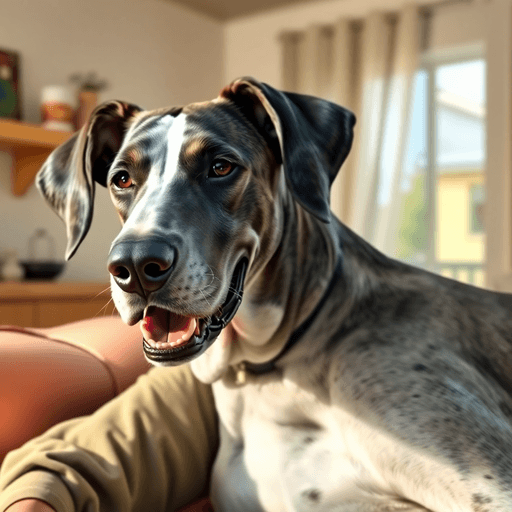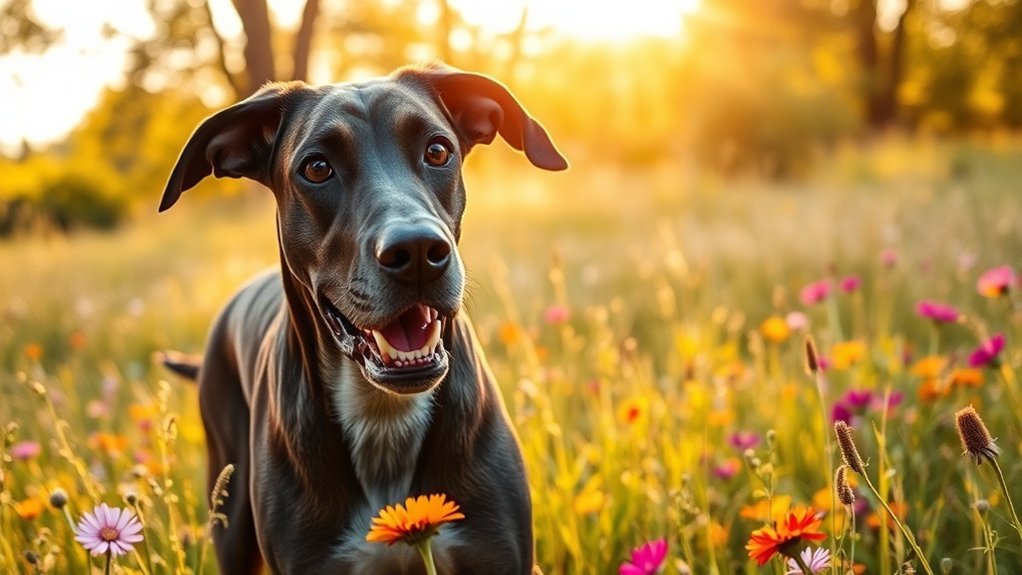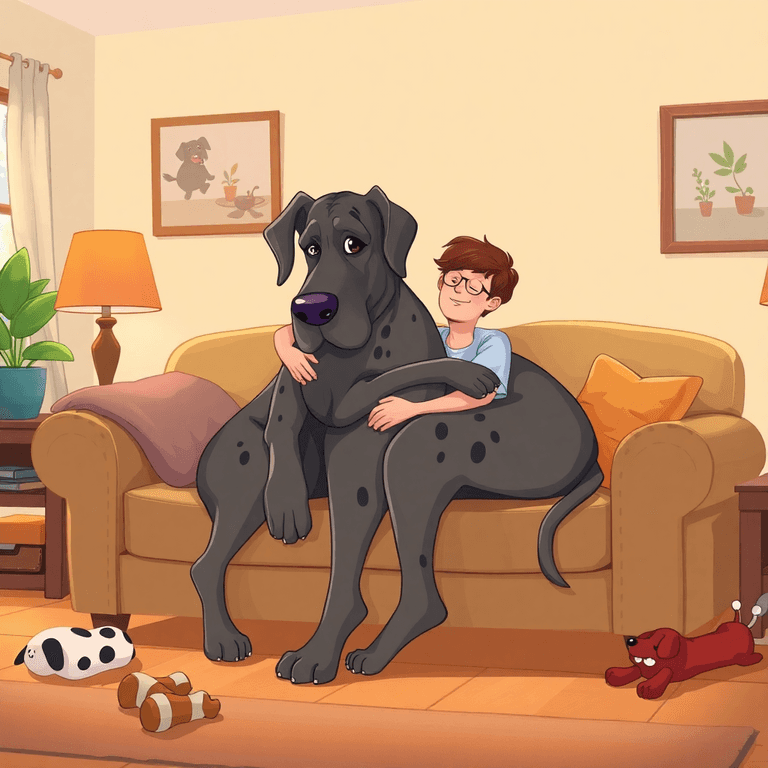Toys, Treats, and Belly Rubs—That’s My Happiness Recipe

Is Your Great Dane Happy
Woof! Let me tell you how my humans can figure out if I’m having a great day or not.
When I’m super happy, my tail goes crazy! I can’t help but wag it so hard that sometimes I knock stuff over. Oops! My humans always laugh when that happens. I also get the zoomies – you know, when I suddenly sprint around the house like a furry tornado. It’s the BEST feeling ever!
When I’m feeling good, my whole body gets wiggly. I can’t sit still because I’m just so excited about everything. I love to play bow – that’s when I put my front end down and my butt up in the air. It’s my way of saying “Hey! Let’s have some fun!”
I also bounce around like a giant puppy when I’m happy. My humans think it’s hilarious because I’m so big but I still act like a little dog sometimes.
But here’s the thing – if I start acting weird or scared, that usually means I need to get out more or play harder. Maybe I haven’t met enough new people lately, or I’ve been stuck inside too long. My humans are pretty good at figuring this stuff out.
The best part is when my humans pay attention to all these signs. It makes me even happier knowing they care about how I’m feeling! Trust me, a happy Great Dane makes for a happy family.
Key Indicators of a Happy Great Dane
How can you tell if I’m a happy Great Dane? Well, let me spill the beans! First off, check out my tail – it’s like a giant windshield wiper when I’m excited. When I’m wagging that massive thing, watch out! I might accidentally knock over your coffee table or clear everything off your kitchen counter. Oops!
You’ll know I’m having a blast when I start my famous “zoomies” around the house. Picture a horse-sized dog bouncing around like a kangaroo – that’s me inviting you to play! I might do my silly play bow where my front end goes down and my butt stays up in the air. It’s my way of saying “Come on, human! Let’s have some fun!”
When I’m feeling good, my whole body is loose and wiggly. My face looks bright and alert, kind of like I’m smiling (because I basically am). I might even do my happy dance, which looks pretty ridiculous considering I’m the size of a small pony. It’s important to note that my relaxed head position and soft ears are also key indicators of my happiness.
If you see me doing these goofy things, you’ll know I’m one content Great Dane. All I want is to feel loved in our home, and trust me, when I’m happy, the whole neighborhood will know it!
The Importance of Socialization and Interaction
Hey there, humans! Let me tell you something important – being a happy Great Dane like me isn’t just about wagging my massive tail so hard it knocks over your coffee table (sorry about that, by the way). It’s also about getting out there and making friends!
Socialization is super essential for us to be giant goofballs. When my humans take me to the dog park, I get to meet all sorts of interesting characters – from tiny Chihuahuas who think they’re tougher than me (which is pretty hilarious) to other gentle giants like myself.
These hangout sessions teach me how to “speak dog” properly and help me feel confident instead of nervous. Plus, meeting new people and exploring different places keeps life exciting! One day I might be sniffing around a new hiking trail, and the next day I could be charming the socks off visitors at a café.
Each adventure helps me learn how to behave like the good boy I am. When we Great Danes don’t get enough social time, we can become anxious or develop weird habits – like deciding your favorite shoes look tasty. Trust me, nobody wants that!
A well-socialized Great Dane like me is way more fun to be around. I’m basically the life of the party, just in a 150-pound package that occasionally forgets how big I am. Plus, early socialization establishes good behaviors that make our interactions even better!
Exercise and Physical Activity Requirements
Woof! Let me tell you about staying in shape when you’re as big as me. I need about an hour of exercise every day to keep my tail wagging and my giant paws moving. Trust me, when I don’t get enough action, I turn into a 150-pound couch potato, and nobody wants that!
My favorite thing ever is when my humans take me hiking or jogging. I get to sniff a million new smells, chase squirrels (okay, I never actually catch them, but it’s fun trying), and show off my long legs. Sometimes people stare when they see me galloping down the trail—I’m basically a small horse with floppy ears!
Playing fetch is fantastic too, even though I sometimes forget to bring the ball back. Why would I give up my prize?
And tug-of-war? Ha! My humans think they’re strong, but one gentle pull from me and they’re flying across the yard. I try to go easy on them.
The best part about all this running around is how happy it makes me feel. When I’m tired after a good workout, I sleep like a rock (and probably snore loud enough to wake the neighbors). Regular fitness is essential for my long-term health and helps me feel my best!
My humans always say “a tired Great Dane is a happy Great Dane,” and boy, are they right! Plus, all that exercise means I can still fit through doorways. Barely.
Training Tips for a Well-Behaved Great Dane
Training Tips from Your Friendly Great Dane
Hey there, humans! Let me tell you what it’s really like when you’re trying to train us Great Danes. Trust me, I’ve been through this whole process, and I’ve got some insider tips for you.
First off, we absolutely love those treats you give us when we do something right. Seriously, please keep them coming! When you reward us for good behavior, we think, “Oh wow, sitting gets me snacks? I’m going to sit ALL the time!” It’s like magic, but with food involved.
We totally adore those tasty treats! Reward us, and we’ll be sitting like pros in no time!
Now, about those commands – please make up your mind! When you say “sit” but don’t really mean it, we get confused. Are we supposed to sit, or are you just making conversation? We’re big dogs, but we’re not mind readers. Pick a command and stick with it, okay?
Here’s something you mightn’t know: we actually like rules! I know, I know – shocking, right? But having a schedule and knowing what you expect from us makes us feel safe and happy. This is why consistent socialization is crucial for effective training experiences.
We’re basically gentle giants who want to please you, but we need to know what “pleasing you” looks like.
One more thing – keep those training sessions short and fun! We’ve got big bodies, but sometimes our attention spans are more like a puppy’s. Five to ten minutes of training with lots of praise works way better than boring us for an hour.
Be patient with us, and we’ll be the best companions you could ask for. After all, we’re pretty awesome once you figure us out!
Maintaining Health and Well-being for Longevity
Hey there, fellow humans! It’s me, your friendly neighborhood Great Dane, and I need to have a serious talk with you about keeping us gentle giants healthy and happy.
Look, I know we might seem pretty chill most of the time – after all, we’re basically living, breathing teddy bears who happen to be the size of small horses. But just because we act all laid-back doesn’t mean you can slack off on taking care of us!
First things first: food. Oh boy, do we love our food! But here’s the thing – we need the good stuff. I’m talking about the right mix of proteins to keep our muscles strong, healthy fats for our shiny coats, and vitamins to keep everything running smoothly. It’s crucial to maintain calcium-to-phosphorus ratios to promote our skeletal development and prevent health issues.
Sure, that leftover pizza looks tempting, but my stomach is about as big as a small country, and it needs proper fuel to work right.
And please, for the love of tennis balls, take us to the vet regularly! I know, I know – nobody likes going to the doctor. Trust me, I’d rather be napping on your couch than getting poked and prodded.
But those check-ups help catch problems before they become BIG problems, and when you’re my size, big problems are really, really big problems.
Please pay attention to how we’re acting, too. If I’m not bouncing around like my usual goofy self, or if I seem more tired than normal after a walk, that’s my way of telling you something might be wrong.
We can’t exactly text you when we’re not feeling great!
The bottom line is this: take care of us now, and we’ll stick around to knock things off your coffee table for many years to come. Deal?
Final Thoughts
Woof! Let me tell you something – keeping us Great Danes happy isn’t rocket science, but it’s definitely important stuff! Think of it like this: we’re basically giant puppies who need the right mix of fun, friends, and good times to keep our tails wagging.
First off, we LOVE meeting new people and dogs. I mean, come on – have you seen how excited I get when the mailman shows up? That’s because we’re social butterflies, just really, really big ones. Take us to the dog park, invite friends over, or let us say hi to neighbors. Trust me, we’re happiest when we’re making new buddies.
And about exercise – yes, we’re huge, but that doesn’t mean we want to be couch potatoes all day! We need our daily walks and some good playtime. Think of us like gentle giants who love a good game of fetch or a nice stroll around the neighborhood. Just don’t expect us to run marathons – our legs are long, but we’re more about quality time than crazy workouts.
Training is super important too, and honestly, we want to make you proud! We’re smart cookies who love learning new tricks. Plus, when we know the rules, everyone’s happier – especially when it comes to things like not jumping on Grandma with our massive paws.
The bottom line? A happy Great Dane equals a happy family. We want love, attention, and maybe a few belly rubs. Give us that, and we’ll be your loyal, goofy companions forever!







3 Comments